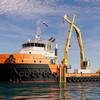Virginia Port, Konecranes Ink Largest ASC Deal
Governor Terry R. McAuliffe announced that The Port of Virginia will finalize the $217 million contract with Konecranes for that company to build and deliver 86 specialized cranes that will be at the center of the port’s expansion projects at Virginia International Gateway (VIG) and Norfolk International Terminals (NIT). The contract is the largest one-time order for automated stacking cranes (ASCs) in industry history.
“The work on making The Port of Virginia the US East Coast’s leading gateway for world trade is truly underway,” McAuliffe said. “We secured the financing for these projects this summer, the planning and preliminary site-work has started and now we have an agreement in place with one of the world’s leading manufacturers of specialized cranes to supply the hardware to move containers safely and efficiently across our two primary container terminals.”
“Once the construction is done and these cranes are in place and operational, our port will have the capacity to process an additional 1 million containers annually, have the channel depth to handle the biggest ships in the Atlantic trade and double-stack rail service offered by Norfolk Southern and CSX to some of the nation’s most important markets.”
At today’s regularly-scheduled meeting, the Virginia Port Authority Board of Commissioners ratified the deal with Konecranes. The contract award covers the purchase of 86 rail-mounted Automated Stacking Cranes: 60 of the cranes will go to NIT and 26 will be headed to VIG. Delivery begins in 2018 and will continue in phases until 2020.
While Konecranes will be providing the cranes, it will be partnering with Roanoke, Virginia-based TMEIC, which will provide the automation technology that drives the unit. Konecranes and TMEIC have had a long partnership that dates back to the construction of VIG and implementation of Automated Stacking Cranes there.
“This project will create jobs and economic spin-off,” McAuliffe said. “One the first beneficiaries of that will be TMEIC, which is a growing company that, with Konecranes, has a global demand for its services: it will be good for TMEIC and it will be good for Virginia.”
Konecranes is a Finnish company and the engineering and manufacturing of key components for the cranes will be done in Finland, the steel structures will be fabricated elsewhere in Europe. The components and structures will then be loaded onto vessels bound The Port of Virginia. The size and scope of the construction process will dictate that some assembly and parts storage take place off-terminal. Konecranes is currently scouting for a regional staging site, where components will be put together and then moved to the terminals for final assembly.
“This project is, and will be generating jobs and investment in Virginia,” said Virginia Secretary of Transportation Aubrey L. Layne. “Konecranes will be using some of its workforce for the project, but will also be hiring, leasing space, possibly partnering with some local contractors or suppliers and it will need hauling firms to move the pieces between the terminals and staging areas.”
“So before we have moved the first container at these expanded facilities, the project is already generating investment and economic benefits in the Commonwealth of Virginia.”
John F. Reinhart, CEO and executive director of the Virginia Port Authority, said the port’s history with Konecranes and the proven TMEIC technology behind the cranes helped to make Konecranes the logical choice. “Konecranes is able to take complete responsibility for this type of very large delivery because the company has extensive crane knowledge and experience from similar large projects,” Reinhart said. “The product is fieldproven, the delivery is on-time and ultimately, on-budget. We’re looking forward to putting them into use and further increase our ability to serve as an economic engine for the Commonwealth.”
By 2020, the port will have expanded the container handling capacity at VIG by 600,000 units and the capacity at NIT by 400,000 units; the combined cost of the projects is $670 million.










